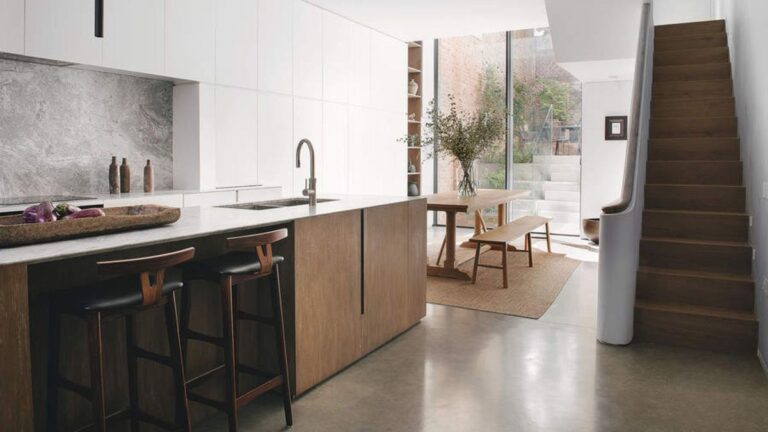Keeping your kitchen cool during a heatwave can be a challenge. The kitchen is the “heart of the home,” meaning it's usually the place where lots of people gather, but as temperatures rise, even the simple act of cooking can feel hot and uncomfortable.
Thankfully, just like keeping the rest of your home cool during a heatwave, there are simple and effective ways to beat the heat and keep your kitchen comfortable no matter how hot it gets outside.
Whether it's choosing the right appliances or moving some furniture around, small changes can make a big difference. Below, HVAC experts and kitchen designers share practical tips and tricks for staying cool while cooking.
How to keep your kitchen cool
Before you rush out to buy the best fan money can buy or turn up your air conditioner to its highest setting, consider these affordable, expert-approved tips for cooling a room.
1. Think about your home appliances
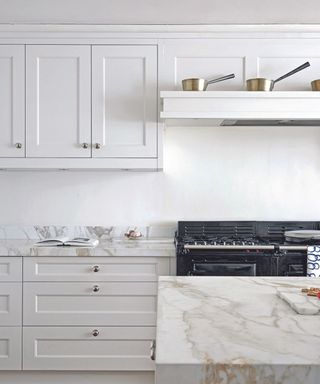
(Image courtesy of Future)
“In the kitchen, ovens, stoves, grills and deep fryers produce the most heat and can be very uncomfortable during heatwaves, especially if they are used for extended periods of time,” explains Eva Lorena, commercial kitchen consultant at Zanduko. “To minimise heat, try to use these appliances during cooler times of the day, such as early morning or evening, and cook in batches to reduce extended cooking times.”
Eva also recommends using cooking appliances like microwaves, slow cookers and air fryers instead of ovens if you want to cut down on the heat coming from your kitchen while you're eating.
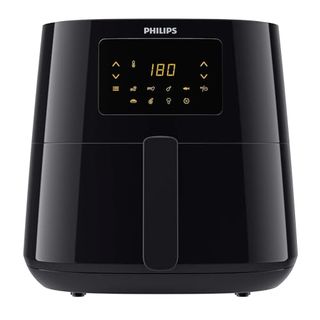
Philips Essential Air Fryer XL
“Dishwashers are also appliances that generate heat during the drying cycle,” says Anees Jarral, CTO at Cielo Wigle, “so try to use them early in the morning or late in the evening when the temperatures outside are cooler.”
“You might also want to consider upgrading your appliances,” adds Melanie Powers, president of Goodbarrett Home Services. “Choose energy-efficient ENERGY STAR appliances. ENERGY STAR appliances like refrigerators have better insulation, and dishwashers have better technology that can reduce cycle times and water usage. Overall, they generate less heat when not in use.”
2. Consider the windows
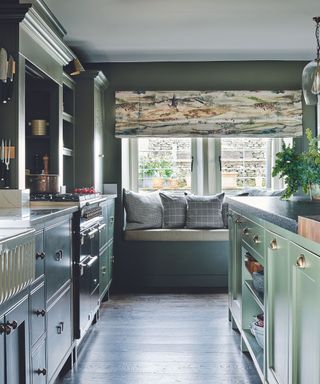
(Image courtesy of Future)
“Keeping windows and doors closed during summer can trap hot air and make your home unbearably hot,” explains Paul Strong, store operations manager at UK-based Magnet Trade. “One of the most effective and cost-effective ways to reduce indoor temperatures during the warmer months is to keep doors and windows open wherever possible.”
It may sound obvious, but having your windows and doors open allows fresh air to circulate throughout your home, removing hot, stale air and replacing it with cooler air from outside. Of course, depending on where you live, leaving your windows open can also attract some unwanted pests. To keep mosquitoes and other flying insects at bay, you can also install netting or screens, like this magnetic door screen from Wayfair.
3. Improve ventilation
Good ventilation is key to keeping a cool kitchen. Start by installing a quality range hood over your stove. These hoods are designed to extract heat, steam and cooking odors and prevent them from circulating back into your kitchen. It's important to ensure that your range hood vents into your vents. Outside Rather than simply circulating air.
Another tip is to strategically place exhaust fans to expel hot air from your kitchen. Exhaust fans should be placed in areas where heat builds up, such as above cooking appliances or near the ceiling where hot air rises.
If installing an exhaust fan is difficult, consider a ceiling fan instead. Although ceiling fans cannot lower the temperature, they can circulate the air and create a wind-chill effect. feel It will keep you cool. One of the best fan directions to cool a room is to have it circulate counterclockwise.
Whatever you do, make sure to clean and maintain your cooling unit and vents to keep them free of grease and dirt. Clogged vents can reduce efficiency and make your kitchen even hotter during hot weather.
4. Be creative with your layout
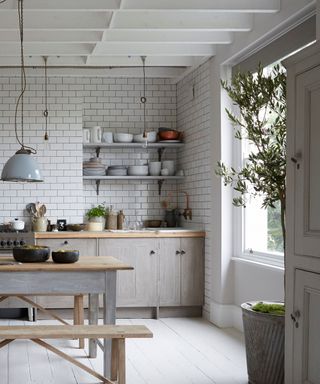
(Image courtesy of Future)
If you're planning a kitchen remodel, now might be the time to consider your kitchen layout to improve airflow. Small kitchens, especially small, enclosed spaces, can make it difficult for air to circulate freely and create more heat. A kitchen with an open layout reduces these potential barriers, allowing air to circulate freely throughout the space. Plus, an open layout allows more natural light in, meaning less artificial lighting, which can create heat.
Of course, if you're not planning on renovating your kitchen anytime soon, consider opting for multifunctional furniture that can be easily moved and adjusted: portable kitchen islands, stylish bar carts and foldable dining tables can all be repositioned to improve airflow and create more space, especially on hot days.
The placement of your appliances is also important. Place heat-producing appliances like ovens and stoves near windows or exterior walls to allow heat to escape. Place refrigerators and freezers out of direct sunlight and away from other heat sources to increase their efficiency, and leave gaps between the refrigerator and walls to allow heat to escape. Finally, try not to pack appliances too close together, as this will trap heat and make your kitchen feel hotter.
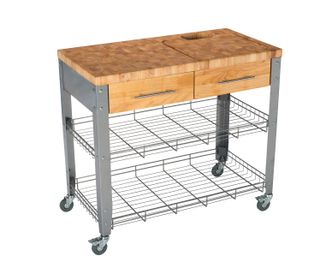
Thielsen Solid Wood Top Kitchen Cart
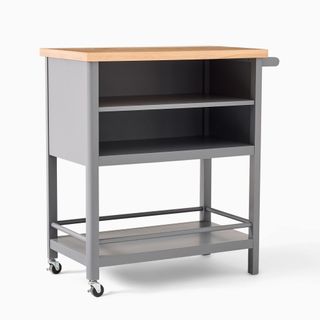
Kaden Rolling Kitchen Cart
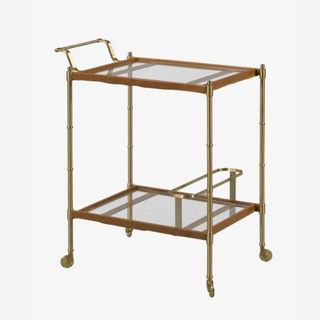
5. Think about shades and colors
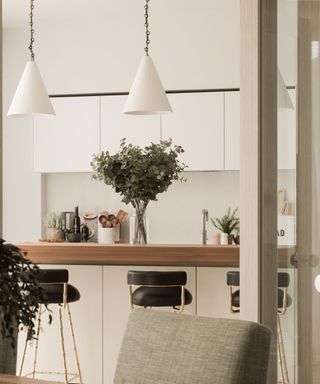
(Image courtesy of Albion Nord)
“If you want to keep your kitchen cool during the hot summer months, consider painting the walls white,” suggests Paul Strong of Magnet Trade. “Dark colors reflect very little sunlight and absorb heat, while lighter colors like white have a high solar reflectance and will reflect a significant portion of the sunlight that hits them, reducing the amount of heat that is transferred into your home.”
“Shading your building is also important to keep your home cool throughout the summer,” Paul continues. For indoor shading, use summer-friendly window treatments like blinds or insulated curtains to keep out the heat.
“Internal shading strategies can be very effective, but external shading strategies can keep roughly 90% of heat out of your home. There are plenty of options to choose from, from parasols and shades to external shutters and blinds.”
FAQ
How can I cool my kitchen faster?
If you need to cool your kitchen quickly, here are some tips that can make a big difference: First, turn on your exhaust fans to expel hot air and circulate it, open windows and doors to improve ventilation, and if you have a portable air conditioner, use it to cool it down quickly.
Skip the oven for mealtimes and opt for no-cook recipes or cold salads instead. Or enjoy al fresco feasts using appliances that don't produce as much heat, like air fryers or slow cookers, or even cook outside on an outdoor grill.
While keeping fresh air circulating in your kitchen is important, HVAC experts suggest that leaving your windows open all day is actually a common mistake during a heatwave. Instead, try this internet-pop window hack and close all your south-facing windows during daylight hours, and open your north-facing windows and doors instead.


